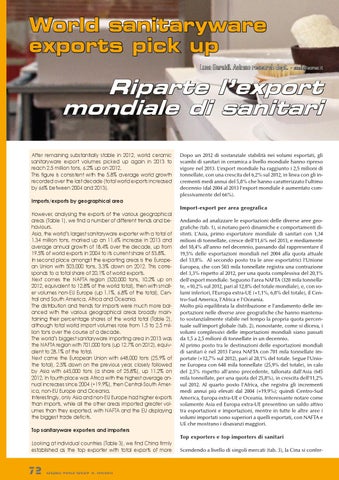World sanitaryware exports pick up Luca Baraldi. Acimac research dept. - studi@acimac.it
Riparte l’export mondiale di sanitari After remaining substantially stable in 2012, world ceramic sanitaryware export volumes picked up again in 2013 to reach 2.5 million tons, 6.2% up on 2012. This figure is consistent with the 5.8% average world growth recorded over the last decade (total world exports increased by 66% between 2004 and 2013). Imports/exports by geographical area However, analysing the exports of the various geographical areas (Table 1), we find a number of different trends and behaviours. Asia, the world’s largest sanitaryware exporter with a total of 1.34 million tons, marked up an 11.6% increase in 2013 and average annual growth of 18.4% over the decade, up from 19.5% of world exports in 2004 to its current share of 53.8%. In second place amongst the exporting areas is the European Union with 503,000 tons, 3.3% down on 2012. This corresponds to a total share of 20.1% of world exports. Next comes the NAFTA region (320,000 tons, 10.2% up on 2012, equivalent to 12.8% of the world total), then with smaller volumes non-EU Europe (up 1.1%, 6.8% of the total), Central and South America, Africa and Oceania. The distribution and trends for imports were much more balanced with the various geographical areas broadly maintaining their percentage shares of the world total (Table 2), although total world import volumes rose from 1.5 to 2.5 million tons over the course of a decade. The world’s biggest sanitaryware importing area in 2013 was the NAFTA region with 701,000 tons (up 12.7% on 2012), equivalent to 28.1% of the total. Next came the European Union with 648,000 tons (25.9% of the total), 2.5% down on the previous year, closely followed by Asia with 645,000 tons (a share of 25.8%), up 11.2% on 2012. In fourth place was Africa with the highest average annual increases since 2004 (+19.9%), then Central-South America, non-EU Europe and Oceania. Interestingly, only Asia and non-EU Europe had higher exports than imports, while all the other areas imported greater volumes than they exported, with NAFTA and the EU displaying the biggest trade deficits. Top sanitaryware exporters and importers Looking at individual countries (Table 3), we find China firmly established as the top exporter with total exports of more
72
C era mic W o rld Review n. 109/ 2014
Dopo un 2012 di sostanziale stabilità nei volumi esportati, gli scambi di sanitari in ceramica a livello mondiale hanno ripreso vigore nel 2013. L’export mondiale ha raggiunto i 2,5 milioni di tonnellate, con una crescita del 6,2% sul 2012, in linea con gli incrementi medi annui del 5,8% che hanno caratterizzato l’ultimo decennio (dal 2004 al 2013 l’export mondiale è aumentato complessivamente del 66%). Import-export per area geografica Andando ad analizzare le esportazioni delle diverse aree geografiche (tab. 1), si notano però dinamiche e comportamenti distinti. L’Asia, primo esportatore mondiale di sanitari con 1,34 milioni di tonnellate, cresce dell’11,6% nel 2013, e mediamente del 18,4% all’anno nel decennio, passando dal rappresentare il 19,5% delle esportazioni mondiali nel 2004 alla quota attuale del 53,8%. Al secondo posto tra le aree esportatrici l’Unione Europea, che con 503 mila tonnellate registra una contrazione del 3,3% rispetto al 2012, per una quota complessiva del 20,1% dell’export mondiale. Seguono l’area NAFTA (320 mila tonnellate, +10,2% sul 2012, pari al 12,8% del totale mondiale), e, con volumi inferiori, l’Europa extra-UE (+1,1%, 6,8% del totale), il Centro-Sud America, l’Africa e l’Oceania. Molto più equilibrata la distribuzione e l’andamento delle importazioni nelle diverse aree geografiche che hanno mantenuto sostanzialmente stabile nel tempo la propria quota percentuale sull’import globale (tab. 2), nonostante, come si diceva, i volumi complessivi delle importazioni mondiali siano passati da 1,5 a 2,5 milioni di tonnellate in un decennio. Al primo posto tra le destinazioni delle esportazioni mondiali di sanitari è nel 2013 l’area NAFTA con 701 mila tonnellate importate (+12,7% sul 2012), pari al 28,1% del totale. Segue l’Unione Europea con 648 mila tonnellate (25,9% del totale), in calo del 2,5% rispetto all’anno precedente, tallonata dall’Asia (645 mila tonnellate, per una quota del 25,8%), in crescita dell’11,2% sul 2012. Al quarto posto l’Africa, che registra gli incrementi medi annui più elevati dal 2004 (+19,9%); quindi Centro-Sud America, Europa extra-UE e Oceania. Interessante notare come solamente Asia ed Europa extra-UE presentino un saldo attivo tra esportazioni e importazioni, mentre in tutte le altre aree i volumi importati sono superiori a quelli esportati, con NAFTA e UE che mostrano i disavanzi maggiori. Top exporters e top importers di sanitari Scendendo a livello di singoli mercati (tab. 3), la Cina si confer-
